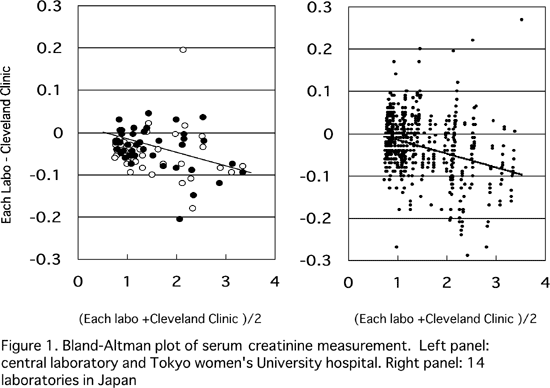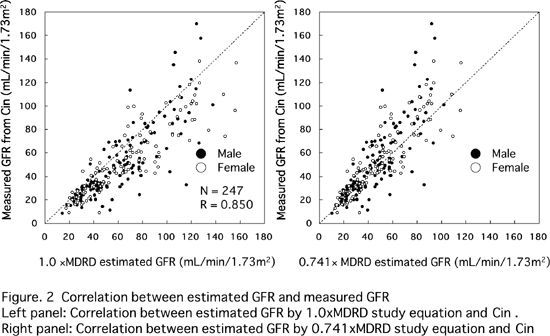3-2
Modification of the MDRD Study equation and development of a new equation
for Japanese patients with CKD.
Masaru Horio, Enyu Imai, Kosaku Nitta, Kunihiro Yamagata, Kunitoshi Iseki,
Yusuke Tsukamoto, Sadayoshi Ito, Hirofumi Makino, Akira Hishida and Seiichi
Matsuo for the Japan Chronic Kidney Disease Initiatives
Background:
Recently, the re-expressed MDRD Study equation with a standardized serum
creatinine was reported (Ann Intern Med 2006, 145:247). In the equation,
creatinine was measured by the enzymatic method using IDMS traceable reference
material. In Japan, most laboratories are using the enzymatic method to
measure creatinine. Application of MDRD equation without calibration of
serum creatinine is quite useful. The MDRD equation may accurately estimate
the white and black population but it is obscure whether the MDRD equation
is appropriate for Japanese population. The purpose of this study was
to validate the MDRD equation by conferring the coefficient and to develop
a new equation for Japanese patients with CKD.
Methods:
Glomerular filtration rate was measured by the gold standard, inulin renal
clearance. Inulin clearance of 116 and 131 Japanese with CKD patients
were obtained from the clinical trial of the safety of inulin. S (samples
were measured at central laboratory) and Tokyo Women's University hospital,
respectively. Serum creatinine values were measured in the two laboratories
by the enzymatic method. We validated the difference of the serum creatinine
measurements between laboratories using a calibration panel composed of
42 serum samples, whose creatinine values were assigned at the Cleveland
Clinic. 214 patients with Cin <90 mL/min/1.73 m2 were used for modification
of the MDRD Study equation and development of a new equation. We calculated
a suitable value of the multiplication factor to minimize the root mean
squared error. New equation was developed by using multiple linear regression.
The regression was performed on log-transformed data (GFR, age, serum
creatinine, gender). We are now accumulating the serum samples and inulin
clearance data of CKD patients from 82 hospitals in Japan. Inulin and
serum creatinine are measured in one laboratory, the central laboratory.
We are planning to use these data for validation and development of a
more accurate Japanese GFR equation.
Results:
The coefficient of variation (CV) for creatinine values from the three
laboratories (Cleveland Clinic, central laboratory, Tokyo Women's University
hospital) was 1.59%. Bland and Altman plot for difference of serum creatinine
value indicated a small proportional error (Fig.1). There was only 2-3%
difference between laboratories in Japan and Cleveland Clinic Laboratory
indicating that inter-laboratory difference in creatinine measurement
by the enzymatic method was very small and the value was allowable for
use in calculation of the MDRD Study equation.
The MDRD Study equation overestimated over the entire range of GFR and
did not perform well for estimating GFR in Japanese patients with CKD
(Fig.2). A Japanese coefficient 0.741 and a new equation by multiple linear
regression improved the accuracy of the MDRD Study equation in subjects
with GFR less than 90 mL/min/1.73m2. There was no significant difference
in accuracy and bias between the modified MDRD Study equation by Japanese
coefficient and the new equation.
Conclusion:
Use of either MDRD Study equation with the Japanese coefficient or the
new equation for estimating GFR significantly improved the estimation
of GFR when less than 90 mL/min/1.73m2. In clinical
practice, the use of either of equations will be encouraged for assessment
of CKD in Japanese patients.

